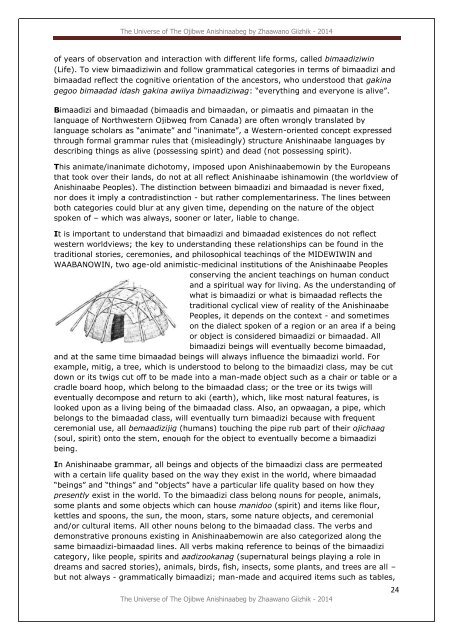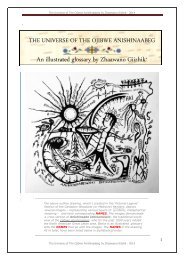The Traditional Anishinaabe World View.pdf
Illustrated glossary offering a cross section of the traditional worldview of the Ojibwe Anishinaabeg, who for the past 1000 years or more inhabit Gaa-zaaga'ekanikaag, the Land of Many Lakes ( the North American Great Lakes area).
Illustrated glossary offering a cross section of the traditional worldview of the Ojibwe Anishinaabeg, who for the past 1000 years or more inhabit Gaa-zaaga'ekanikaag, the Land of Many Lakes ( the North American Great Lakes area).
You also want an ePaper? Increase the reach of your titles
YUMPU automatically turns print PDFs into web optimized ePapers that Google loves.
<strong>The</strong> Universe of <strong>The</strong> Ojibwe <strong>Anishinaabe</strong>g by Zhaawano Giizhik - 2014<br />
of years of observation and interaction with different life forms, called bimaadiziwin<br />
(Life). To view bimaadiziwin and follow grammatical categories in terms of bimaadizi and<br />
bimaadad reflect the cognitive orientation of the ancestors, who understood that gakina<br />
gegoo bimaadad idash gakina awiiya bimaadiziwag: “everything and everyone is alive”.<br />
Bimaadizi and bimaadad (bimaadis and bimaadan, or pimaatis and pimaatan in the<br />
language of Northwestern Ojibweg from Canada) are often wrongly translated by<br />
language scholars as “animate” and “inanimate”, a Western-oriented concept expressed<br />
through formal grammar rules that (misleadingly) structure <strong>Anishinaabe</strong> languages by<br />
describing things as alive (possessing spirit) and dead (not possessing spirit).<br />
This animate/inanimate dichotomy, imposed upon <strong>Anishinaabe</strong>mowin by the Europeans<br />
that took over their lands, do not at all reflect <strong>Anishinaabe</strong> ishinamowin (the worldview of<br />
<strong>Anishinaabe</strong> Peoples). <strong>The</strong> distinction between bimaadizi and bimaadad is never fixed,<br />
nor does it imply a contradistinction - but rather complementariness. <strong>The</strong> lines between<br />
both categories could blur at any given time, depending on the nature of the object<br />
spoken of – which was always, sooner or later, liable to change.<br />
It is important to understand that bimaadizi and bimaadad existences do not reflect<br />
western worldviews; the key to understanding these relationships can be found in the<br />
traditional stories, ceremonies, and philosophical teachings of the MIDEWIWIN and<br />
WAABANOWIN, two age-old animistic-medicinal institutions of the <strong>Anishinaabe</strong> Peoples<br />
conserving the ancient teachings on human conduct<br />
and a spiritual way for living. As the understanding of<br />
what is bimaadizi or what is bimaadad reflects the<br />
traditional cyclical view of reality of the <strong>Anishinaabe</strong><br />
Peoples, it depends on the context - and sometimes<br />
on the dialect spoken of a region or an area if a being<br />
or object is considered bimaadizi or bimaadad. All<br />
bimaadizi beings will eventually become bimaadad,<br />
and at the same time bimaadad beings will always influence the bimaadizi world. For<br />
example, mitig, a tree, which is understood to belong to the bimaadizi class, may be cut<br />
down or its twigs cut off to be made into a man-made object such as a chair or table or a<br />
cradle board hoop, which belong to the bimaadad class; or the tree or its twigs will<br />
eventually decompose and return to aki (earth), which, like most natural features, is<br />
looked upon as a living being of the bimaadad class. Also, an opwaagan, a pipe, which<br />
belongs to the bimaadad class, will eventually turn bimaadizi because with frequent<br />
ceremonial use, all bemaadizijig (humans) touching the pipe rub part of their ojichaag<br />
(soul, spirit) onto the stem, enough for the object to eventually become a bimaadizi<br />
being.<br />
In <strong>Anishinaabe</strong> grammar, all beings and objects of the bimaadizi class are permeated<br />
with a certain life quality based on the way they exist in the world, where bimaadad<br />
“beings” and “things” and “objects” have a particular life quality based on how they<br />
presently exist in the world. To the bimaadizi class belong nouns for people, animals,<br />
some plants and some objects which can house manidoo (spirit) and items like flour,<br />
kettles and spoons, the sun, the moon, stars, some nature objects, and ceremonial<br />
and/or cultural items. All other nouns belong to the bimaadad class. <strong>The</strong> verbs and<br />
demonstrative pronouns existing in <strong>Anishinaabe</strong>mowin are also categorized along the<br />
same bimaadizi-bimaadad lines. All verbs making reference to beings of the bimaadizi<br />
category, like people, spirits and aadizookanag (supernatural beings playing a role in<br />
dreams and sacred stories), animals, birds, fish, insects, some plants, and trees are all –<br />
but not always - grammatically bimaadizi; man-made and acquired items such as tables,<br />
<strong>The</strong> Universe of <strong>The</strong> Ojibwe <strong>Anishinaabe</strong>g by Zhaawano Giizhik - 2014<br />
24





